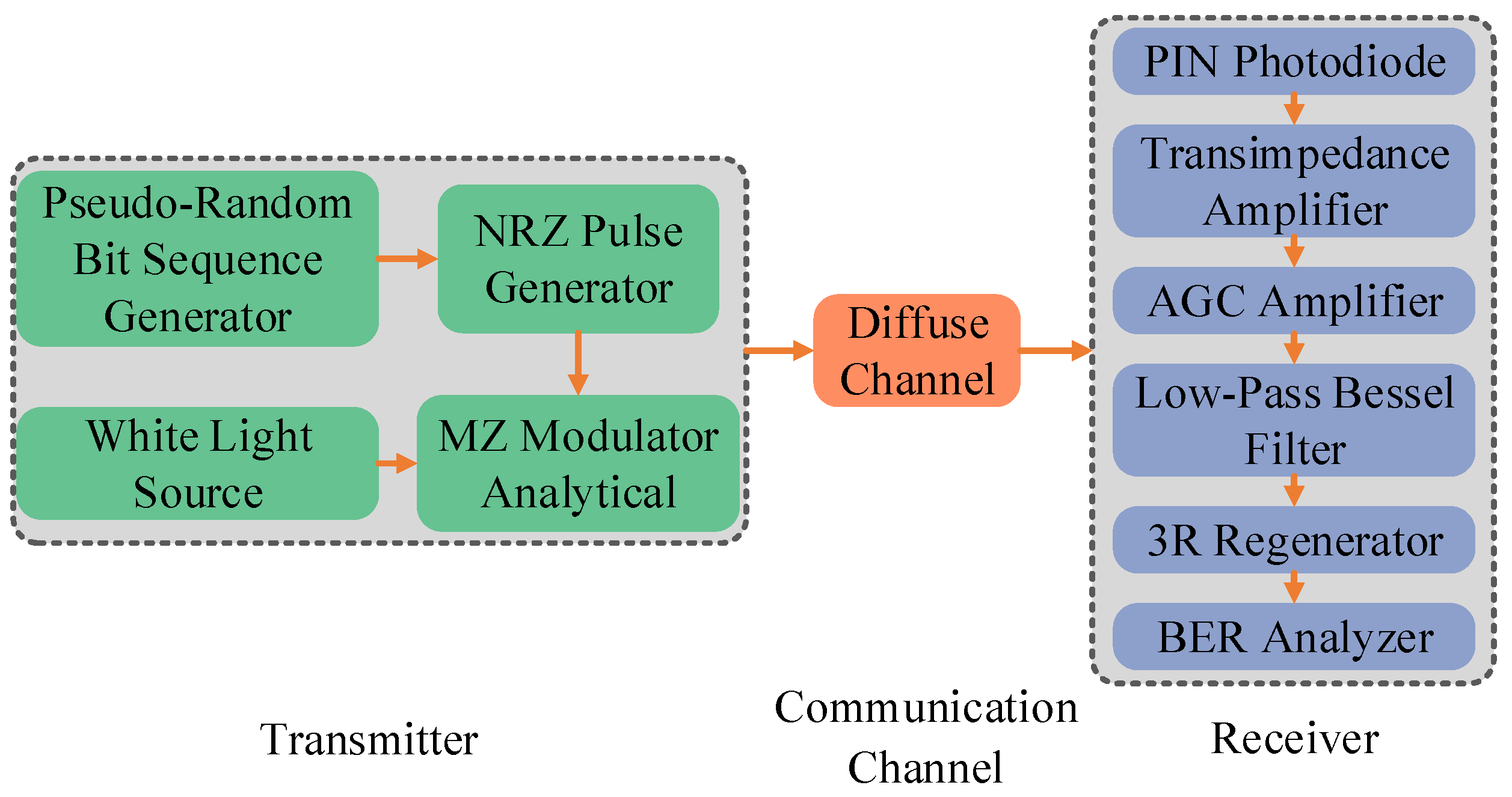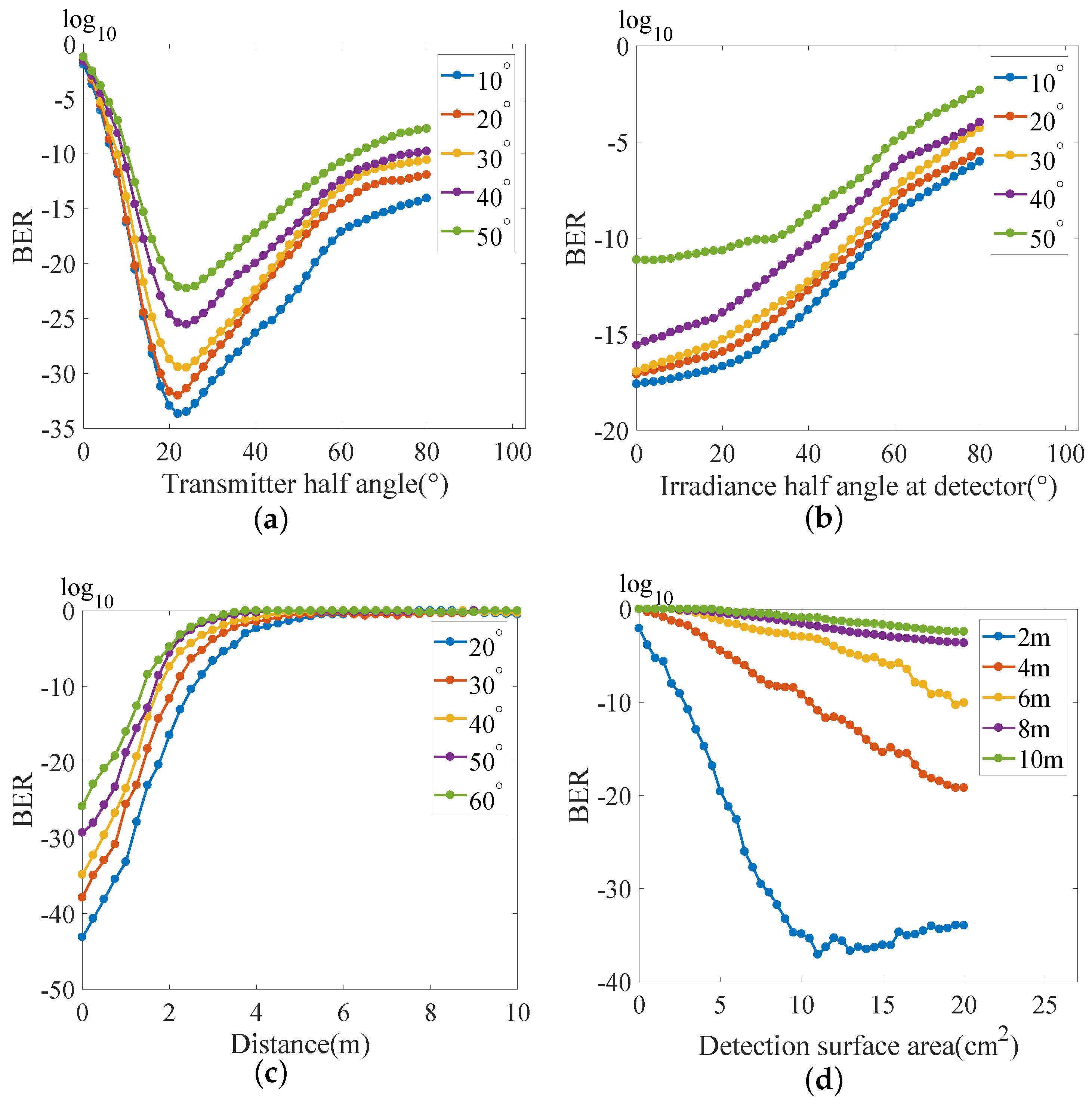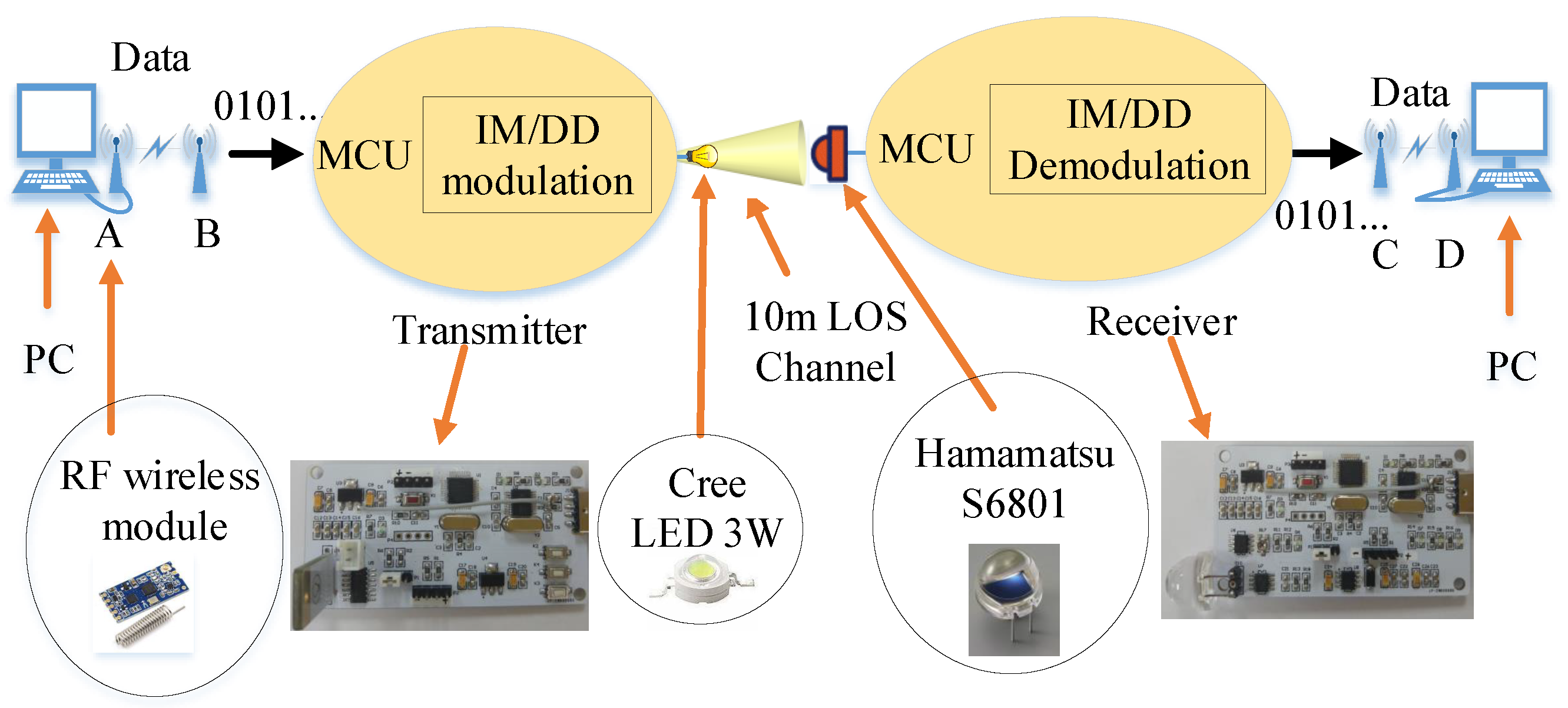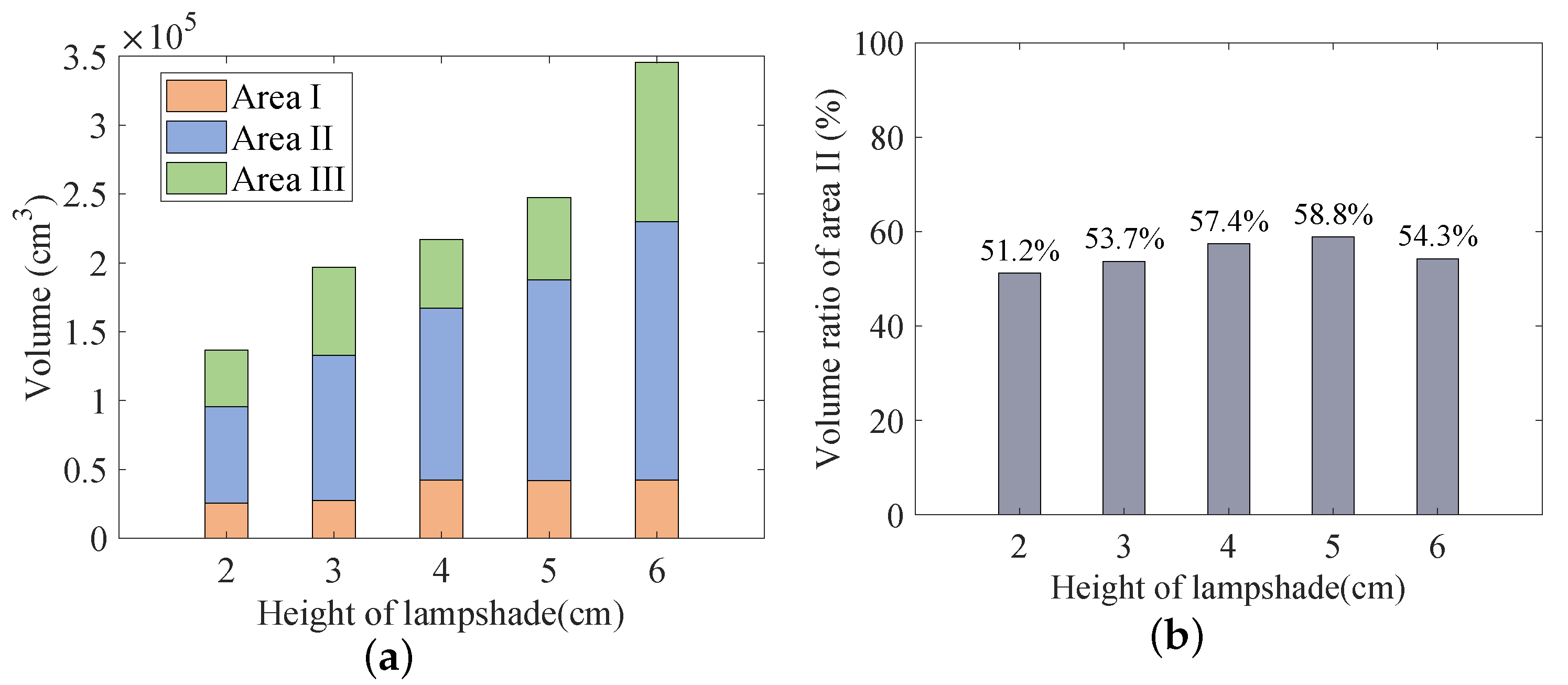Three-Dimensional Division of Visible Light Communication Irradiation Area
Abstract
1. Introduction
2. Theoretical Model of VLC
3. Theoretical Simulation and Analysis of VLC
3.1. Simulation Model
3.2. Simulation Results and Analysis
4. VLC Experiment Setup and Discussion
4.1. Experiment Setup
4.2. Experimental Results
4.3. Establishment of 3D Model
4.4. Results Discussion
5. Summary
Author Contributions
Funding
Institutional Review Board Statement
Informed Consent Statement
Data Availability Statement
Acknowledgments
Conflicts of Interest
References
- Burchardt, H.; Serafimovski, N.; Tsonev, D.; Videv, S.; Haas, H. VLC: Beyond point-to-point communication. IEEE Commun. Mag. 2014, 52, 98–105. [Google Scholar] [CrossRef]
- Kahn, J.M.; Barry, J.R. Wireless infrared communications. Proc. IEEE 1997, 85, 265–298. [Google Scholar] [CrossRef]
- Vegni, A.M.; Biagi, M. Optimal LED placement in indoor VLC networks. Opt. Express 2019, 27, 8504–8519. [Google Scholar] [CrossRef] [PubMed]
- Lee, C.M.; Li, B.H.; Chiang, C.C. Optimization of Bit Allocation for Spatial Multiplexing in MIMO VLC System with Smartphones. Sensors 2022, 22, 8117. [Google Scholar] [CrossRef] [PubMed]
- Haas, H.; Yin, L.; Wang, Y.; Chen, C. What is LiFi? J. Light. Technol. 2016, 34, 1533–1544. [Google Scholar] [CrossRef]
- Gu, W.; Aminikashani, M.; Deng, P.; Kavehrad, M. Impact of Multipath Reflections on the Performance of Indoor Visible Light Positioning Systems. J. Light. Technol. 2016, 34, 2578–2587. [Google Scholar] [CrossRef]
- Huang, H.; Lin, B.; Feng, L.; Lv, H. Hybrid indoor localization scheme with image sensor-based visible light positioning and pedestrian dead reckoning. Appl. Opt. 2019, 58, 3214–3221. [Google Scholar] [CrossRef]
- Xu, B.; Hussain, B.; Wang, Y.; Cheng, H.C.; Yue, C.P. Smart Home Control System Using VLC and Bluetooth Enabled AC Light Bulb for 3D Indoor Localization with Centimeter-Level Precision. Sensors 2022, 22, 8181. [Google Scholar] [CrossRef] [PubMed]
- Woo, J.; Jo, S.H.; Byun, G.S.; Kim, S.Y.; Jee, S.G.; Seong, J.H.; Jeong, Y.M.; Jeong, J.H. Determination of Traffic Lane in Tunnel and Positioning of Autonomous Vehicles Using Chromaticity of LED Lights. Sensors 2022, 22, 2912. [Google Scholar] [CrossRef]
- Torres, J.C.; Montes, A.; Mendoza, S.L.; Fernández, P.R.; Betancourt, J.S.; Escandell, L.; del Valle, C.I.; Sánchez-Pena, J.M. A Low-Cost Visible Light Positioning System for Indoor Positioning. Sensors 2020, 20, 5145. [Google Scholar] [CrossRef]
- Béchadergue, B.; Chassagne, L.; Guan, H. Experimental comparison of pulse-amplitude and spatial modulations for vehicle-to-vehicle visible light communication in platoon configurations. Opt. Express 2017, 25, 24790–24802. [Google Scholar] [CrossRef] [PubMed]
- Oh, S.; Lee, Y.; Yu, M.; Cho, S.; Javed, S.; Chun, H. Smart License Plate in Combination with Fluorescent Concentrator for Vehicular Visible Light Communication System. Sensors 2022, 22, 2485. [Google Scholar] [CrossRef] [PubMed]
- Kim, Y.H.; Chung, Y.H. Experimental demonstration of highway I2V using visible light communications. Appl. Opt. 2016, 55, 5840–5845. [Google Scholar] [CrossRef] [PubMed]
- Căilean, A.M.; Beguni, C.; Avătămăniței, S.A.; Dimian, M.; Popa, V. Design, Implementation and Experimental Investigation of a Pedestrian Street Crossing Assistance System Based on Visible Light Communications. Sensors 2022, 22, 5481. [Google Scholar] [CrossRef]
- Huang, X.; Wang, Z.; Shi, J.; Wang, Y.; Chi, N. 16 Gbit/s phosphorescent white LED based VLC transmission using a cascaded pre-equalization circuit and a differential outputs PIN receiver. Opt. Express 2015, 23, 22034. [Google Scholar] [CrossRef]
- Hu, X.; Zhang, P.; Sun, Y.; Deng, X.; Yang, Y.; Chen, L. High-Speed Extraction of Regions of Interest in Optical Camera Communication Enabled by Grid Virtual Division. Sensors 2022, 22, 8375. [Google Scholar] [CrossRef]
- Beguni, C.; Căilean, A.M.; Avătămăniței, S.A.; Zadobrischi, E.; Stoler, R.; Dimian, M.; Popa, V.; Béchadergue, B.; Chassagne, L. In-Vehicle Visible Light Communications Data Transmission System Using Optical Fiber Distributed Light: Implementation and Experimental Evaluation. Sensors 2022, 22, 6738. [Google Scholar] [CrossRef]
- Qin, B.; Wen, W.; Liu, M.; Zhang, Y.; Chen, C. Indoor MIMO-VLC Using Angle Diversity Transmitters. Sensors 2022, 22, 5436. [Google Scholar] [CrossRef]
- Ho, K.T.; Chen, R.; Liu, G.; Shen, C.; Holguin-Lerma, J.; Al-Saggaf, A.; Ng, T.K.; Alouini, M.S.; He, J.H.; Ooi, B. 3.2 Gigabit-per-second Visible Light Communication Link with InGaN/GaN MQW Micro-photodetector. Opt. Express 2018, 26, 3037. [Google Scholar] [CrossRef]
- Lu, H.; Hong, Y.; Chen, L.K.; Wang, J. On the study of the relation between linear/nonlinear PAPR reduction and transmission performance for OFDM-based VLC systems. Opt. Express 2018, 26, 13891. [Google Scholar] [CrossRef]
- Wang, Y.; Tao, L.; Huang, X.; Shi, J.; Chi, N. 8-Gb/s RGBY LED based WDM VLC system employing high-order CAP modulation and hybrid post equalizer. IEEE Photonics J. 2015, 7, 7904507. [Google Scholar]
- Li, H.; Chen, X.; Guo, J.; Gao, Z.; Chen, H. An analog modulator for 460 MB/S visible light data transmission based on OOK-NRS modulation. IEEE Wirel. Commun. 2015, 22, 68–73. [Google Scholar] [CrossRef]
- Wei, L.Y.; Chow, C.W.; Chen, G.H.; Liu, Y.; Yeh, C.H.; Hsu, C.W. Tricolor visible-light laser diodes based visible light communication operated at 40.665 Gbit/s and 2 m free-space transmission. Opt. Express 2019, 27, 25072–25077. [Google Scholar] [CrossRef]
- Fahs, B.; Chellis, J.; Senneca, M.J.; Chowdhury, A.; Ray, S.; Mirvakili, A.; Mazzara, B.; Zhang, Y.; Ghasemi, J.; Miao, Y.; et al. A 6-m OOK VLC Link Using CMOS-Compatible p-n Photodiode and Red LED. IEEE Photonics Technol. Lett. 2016, 28, 2846–2849. [Google Scholar] [CrossRef]
- Bui, T.C.; Cusani, R.; Scarano, G.; Biagi, M. Metameric MIMO-OOK transmission scheme using multiple RGB LEDs. Opt. Express 2018, 26, 14038. [Google Scholar] [CrossRef]
- Hong, Y.; Xu, J.; Chen, L.K. Experimental investigation of multi-band OCT precoding for OFDM-based visible light communications. Opt. Express 2017, 25, 12908–12914. [Google Scholar] [CrossRef]
- Xu, R.; Chen, M. A precoding scheme for DFT-based OFDM to suppress sidelobes. IEEE Commun. Lett. 2009, 13, 776–778. [Google Scholar] [CrossRef]
- Zhang, G.; Zhang, J.; Hong, X.; He, S. Low-complexity frequency domain nonlinear compensation for OFDM based high-speed visible light communication systems with light emitting diodes. Opt. Express 2017, 25, 3780. [Google Scholar] [CrossRef]
- Retamal, J.R.D.; Oubei, H.M.; Janjua, B.; Chi, Y.C.; Wang, H.Y.; Tsai, C.T.; Ng, T.K.; Hsieh, D.H.; Kuo, H.C.; Alouini, M.S. 4-Gbit/s visible light communication link based on 16-QAM OFDM transmission over remote phosphor-film converted white light by using blue laser diode. Opt. Express 2015, 23, 33656. [Google Scholar] [CrossRef]
- Kumar, C.R.; Jeyachitra, R.K. Dual-Mode Generalized Spatial Modulation MIMO for Visible Light Communications. IEEE Commun. Lett. 2018, 22, 280–283. [Google Scholar] [CrossRef]
- Chen, C.; Zhong, W.; Zhao, L. Sparse Bayesian RVM regression based channel estimation for IM/DD OFDM-VLC systems with reduced training overhead. In Proceedings of the 2017 IEEE International Conference on Communications Workshops (ICC Workshops), Paris, France, 21–25 May 2017; pp. 162–167. [Google Scholar] [CrossRef]
- Dissanayake, S.D.; Panta, K.; Armstrong, J. A novel technique to simultaneously transmit ACO-OFDM and DCO-OFDM in IM/DD systems. In Proceedings of the 2011 IEEE GLOBECOM Workshops (GC Wkshps), Houston, TX, USA, 5–9 December 2011; pp. 782–786. [Google Scholar] [CrossRef]
- Mohanna, M.; El-Kammar, R.A.; Lotfyrabeh, M.; Gabr, M.I. Visible Light Communication (VLC) Channel Modeling. Int. J. Comput. Sci. Eng. 2018, 5, 2320–2394. [Google Scholar]
- Priyanka; Singh, M.L.; Singh, M.; Gill, H.S.; Kaur, S. Quantitative analysis of different LED lamp configurations in indoor VLC system. Int. J. Commun. Syst. 2021, 34, e4916. [Google Scholar] [CrossRef]
- Long, Z. Optical Wireless Systems Channel Modelling. J. Comput. Commun. 2022, 10, 20. [Google Scholar] [CrossRef]
- Sc, A.; Lm, A.; Fcb, C.; Ms, B.; Tn, D.; Jcd, B. Measurement-based VLC channel characterization for I2V communications in a real urban scenario. Veh. Commun. 2020, 28, 100305. [Google Scholar]
- Ding, J.; I, C.L.; Wang, J.; Yang, H. Effects of Optical Beams on MIMO Visible Light Communication Channel Characteristics. Sensors 2021, 22, 216. [Google Scholar] [CrossRef]
- Zhu, X.; Wang, C.X.; Huang, J.; Chen, M.; Haas, H. A Novel 3D Non-Stationary Channel Model for 6G Indoor Visible Light Communication Systems. IEEE Trans. Wirel. Commun. 2022, 21, 8292–8307. [Google Scholar] [CrossRef]
- Palacios Játiva, P.; Azurdia-Meza, C.; Sánchez, I.; Zabala-Blanco, D.; Dehghan Firoozabadi, A.; Soto, I.; Seguel, F. An Enhanced VLC Channel Model for Underground Mining Environments Considering a 3D Dust Particle Distribution Model. Sensors 2022, 22, 2483. [Google Scholar] [CrossRef]
- Li, L.; Zhu, Z.; Zhang, J. Neural Network-Based Transceiver Design for VLC System over ISI Channel. Photonics 2022, 9, 190. [Google Scholar] [CrossRef]
- Mousa, F.; Almaadeed, N.; Busawon, K.; Bouridane, A.; Elliot, I. Indoor visible light communication localization system utilizing received signal strength indication technique and trilateration method. Opt. Eng. 2018, 57, 11. [Google Scholar]
- Mmbaga, P.F.; Thompson, J.; Haas, H. Performance Analysis of Indoor Diffuse VLC MIMO Channels Using Angular Diversity Detectors. J. Light. Technol. 2016, 34, 1254–1266. [Google Scholar] [CrossRef]
- Hou, J.; O’Brien, D. Polling scheme for indoor LOS optical wireless LAN. Electron. Lett. 2003, 39, 794–795. [Google Scholar] [CrossRef]
- Hashemi, H.; Yun, G.; Kavehrad, M.; Behbahani, F.; Galko, P.A. Indoor propagation measurements at infrared frequencies for wireless local area networks applications. IEEE Trans. Veh. Technol. 1994, 43, 562–576. [Google Scholar] [CrossRef]
- Barry, J.R.; Kahn, J.M.; Krause, W.J.; Lee, E.A.; Messerschmitt, D.G. Simulation of multipath impulse response for indoor wireless optical channels. IEEE J. Sel. Areas Commun. 1993, 11, 367–379. [Google Scholar] [CrossRef]












| Parameters | Values |
|---|---|
| Transmitter half angle (°) | 60 |
| Irradiance half angle at detector (°) | 20 |
| Irradiance half angle at source (°) | 20 |
| Communication distance (m) | 1 |
| Detection surface area (cm) | 1 |
| Lampshade Height (cm) | 2 | 3 | 4 | 5 | 6 |
|---|---|---|---|---|---|
| d (cm) | 24 | 25 | 25 | 24 | 24 |
| (cm) | 10 | 10 | 20 | 20 | 20 |
| d (cm) | 12 | 12 | 13 | 14 | 14 |
| (cm) | 100 | 100 | 150 | 150 | 150 |
| d (cm) | 22 | 24 | 24 | 26 | 31 |
| + (cm) | 400 | 500 | 600 | 600 | 600 |
| + + (cm) | 725 | 923 | 930 | 938 | 1060 |
Disclaimer/Publisher’s Note: The statements, opinions and data contained in all publications are solely those of the individual author(s) and contributor(s) and not of MDPI and/or the editor(s). MDPI and/or the editor(s) disclaim responsibility for any injury to people or property resulting from any ideas, methods, instructions or products referred to in the content. |
© 2022 by the authors. Licensee MDPI, Basel, Switzerland. This article is an open access article distributed under the terms and conditions of the Creative Commons Attribution (CC BY) license (https://creativecommons.org/licenses/by/4.0/).
Share and Cite
Zhou, Y.; Deng, Y.; Wen, H.; Chen, L.; Xu, G. Three-Dimensional Division of Visible Light Communication Irradiation Area. Sensors 2023, 23, 94. https://doi.org/10.3390/s23010094
Zhou Y, Deng Y, Wen H, Chen L, Xu G. Three-Dimensional Division of Visible Light Communication Irradiation Area. Sensors. 2023; 23(1):94. https://doi.org/10.3390/s23010094
Chicago/Turabian StyleZhou, Yang, Yuanzhi Deng, Huajie Wen, Liting Chen, and Gang Xu. 2023. "Three-Dimensional Division of Visible Light Communication Irradiation Area" Sensors 23, no. 1: 94. https://doi.org/10.3390/s23010094
APA StyleZhou, Y., Deng, Y., Wen, H., Chen, L., & Xu, G. (2023). Three-Dimensional Division of Visible Light Communication Irradiation Area. Sensors, 23(1), 94. https://doi.org/10.3390/s23010094






